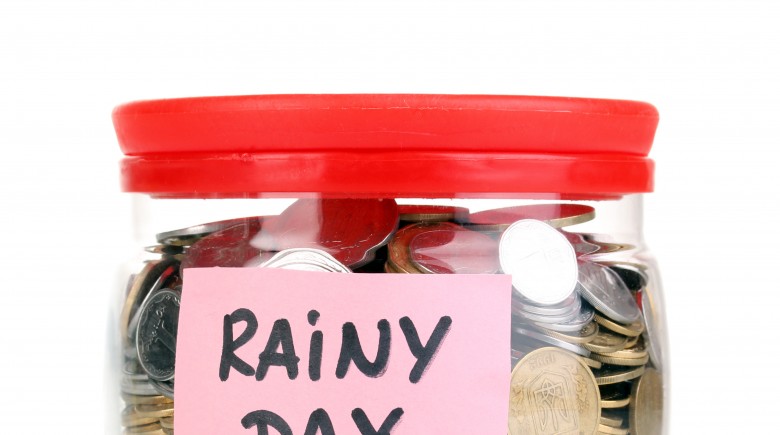Ask yourself an honest question: How prepared am I to handle a financial emergency?
Maybe you’re good with money and have a stable job, in which case, you might have a false sense of security. However, financial emergencies can happen to anyone. Talk with anyone who’s been laid off from work – the job loss might have come as a surprise. But losing a job isn’t the only financial crisis you may face. Your car might break down, you may have to leave town unexpectedly or you may need an immediate house repair. Whatever the situation, being prepared and having a rainy day fund can keep your ahead above water.
A rainy day fund is basically a savings account that’s only used for emergencies. This is separate from other savings accounts you might have, such as a retirement account or a vacation account. You no doubt see the importance of setting aside cash for emergencies. Of course, this is easier said than done. Emergencies don’t typically happen everyday, and when they’re far and few between, there’s temptation to dip into this account and have a little fun. Don’t. It’s not a matter of whether an emergency will happen – but when.
So, how much do you need?
There are no specific rules. However, three to six months of liquid cash is usually enough to help most people whether financial storms, according to Dave Ramsey. If you bring home $3,000 a month, aim for at least $9,000 in your rainy day fund. This can relieve some of the burden and stress while you’re looking for a new job or handling other personal matters. This approach is often cheaper than applying for a personal loan or using a credit card, which results in another monthly bill and high interest charges. Plus, you don’t have to borrow from friends and family, which keeps your private matter private.
Approximately 49% of Americans do not have enough in their emergency savings to cover three month’s worth of expenses, and worse, about 28% don’t have any type of savings, according to a 2012 survey by Bankrate.com. How does your savings compare? Do you need a little boost? Here are three tips to get you started.
1. Pay yourself first.
The same way you make the mortgage and car payment a priority, make saving a priority. Cash your check and take 10% off the top – or whatever you can afford – and deposit this money into your emergency fund. Do this consistently and you’ll gradually build a nice safety net.
2. Save your extra money.
Don’t waste your tax returns and work bonuses on non-essentials, especially if you have little to nothing in your emergency savings account. Consider opening a high-yield savings account to maximize your return and grow your account faster.
3. Go on a 30-day spending diet.
Jumpstart your rainy day fund with a 30-day spending diet. Only spend money on essential expenses, such as housing, transportation, groceries, utilities and other bills. Don’t spend a dime on clothes, entertainment, recreation, takeout food and other miscellaneous expenses that add up. Deposit the savings into your account.
Ask yourself an honest question: How prepared am I to handle a financial emergency?
Maybe you’re good with money and have a stable job, in which case, you might have a false sense of security. However, financial emergencies can happen to anyone. Talk with anyone who’s been laid off from work – the job loss might have come as a surprise. But losing a job isn’t the only financial crisis you may face. Your car might break down, you may have to leave town unexpectedly or you may need an immediate house repair. Whatever the situation, being prepared and having a rainy day fund can keep your ahead above water.
A rainy day fund is basically a savings account that’s only used for emergencies. This is separate from other savings accounts you might have, such as a retirement account or a vacation account. You no doubt see the importance of setting aside cash for emergencies. Of course, this is easier said than done. Emergencies don’t typically happen everyday, and when they’re far and few between, there’s temptation to dip into this account and have a little fun. Don’t. It’s not a matter of whether an emergency will happen – but when.
So, how much do you need?
There are no specific rules. However, three to six months of liquid cash is usually enough to help most people whether financial storms, according to Dave Ramsey. If you bring home $3,000 a month, aim for at least $9,000 in your rainy day fund. This can relieve some of the burden and stress while you’re looking for a new job or handling other personal matters. This approach is often cheaper than applying for a personal loan or using a credit card, which results in another monthly bill and high interest charges. Plus, you don’t have to borrow from friends and family, which keeps your private matter private.
Approximately 49% of Americans do not have enough in their emergency savings to cover three month’s worth of expenses, and worse, about 28% don’t have any type of savings, according to a 2012 survey by Bankrate.com. How does your savings compare? Do you need a little boost? Here are three tips to get you started.
1. Pay yourself first.
The same way you make the mortgage and car payment a priority, make saving a priority. Cash your check and take 10% off the top – or whatever you can afford – and deposit this money into your emergency fund. Do this consistently and you’ll gradually build a nice safety net.
2. Save your extra money.
Don’t waste your tax returns and work bonuses on non-essentials, especially if you have little to nothing in your emergency savings account. Consider opening a high-yield savings account to maximize your return and grow your account faster.
3. Go on a 30-day spending diet.
Jumpstart your rainy day fund with a 30-day spending diet. Only spend money on essential expenses, such as housing, transportation, groceries, utilities and other bills. Don’t spend a dime on clothes, entertainment, recreation, takeout food and other miscellaneous expenses that add up. Deposit the savings into your account.







